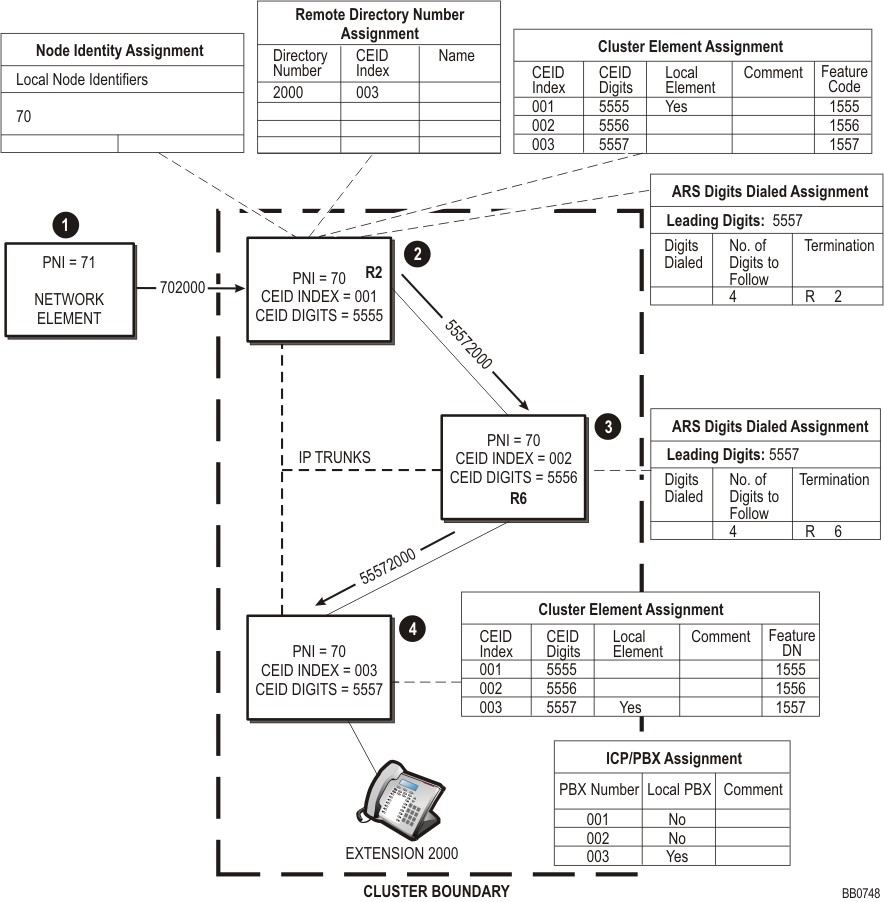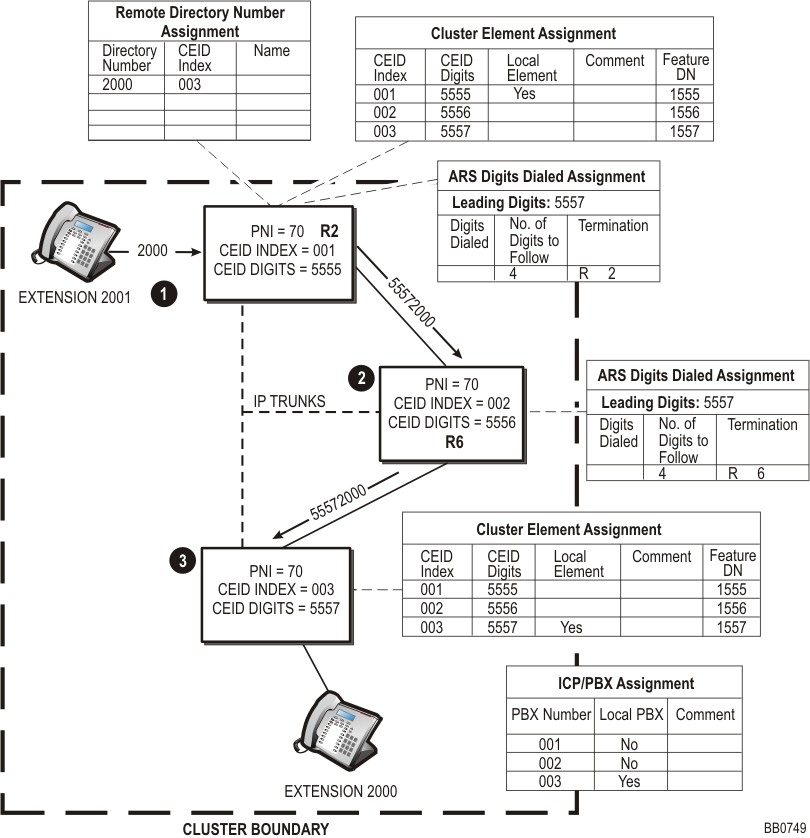
Because all of the elements in a cluster share the same PNI, other network elements interpret the cluster as a single network element. When a cluster element receives a call it examines the PNI prefixed to the dialed number to determine if it is its own PNI. If it is, it strips off the PNI, leaving just the extension number. Since every cluster element has the same PNI, the number could belong to an extension residing on any one of the cluster elements.
To route the call to the correct cluster element, each cluster element has a Remote Directory Numbers form that lists every remote extension number. This form associates each extension number with a CEID index in the Cluster Elements form. The CEID index designates the local cluster element of the extension (the cluster element on which the extension resides). Each cluster element has a unique 1 to 3-digit CEID index. The CEID index references a 1- to 7-digit CEID digit string. Each CEID digit string translates to an ARS route, list, or plan with identical leading digits.
Once the cluster element receives the call and identifies the called party's CEID index, it examines the associated ARS routing digits in its Cluster Elements form. It then prefixes the ARS routing digits (CEID digits) to the extension number. ARS then routes the call to the cluster element where the extension resides.
Figure 1 illustrates how a cluster handles an inbound call from another element in the network.
Stage 1 - a caller on network element 71 dials 702000. Network element 71 sends the digits to an element in the cluster which has a PNI of 70 (each cluster element has 70 as its PNI).
Stage 2 - the cluster element receiving the call identifies the 70 as its own PNI. It strips off the PNI and checks for a dialable string of 2000 in its digit tree. When it determines that 2000 is a Remote Directory number, it references the CEID index for 2000, which is 003. This number indexes the Cluster Elements form which translates 003 to 5557. The digit string 5557 is the ARS string that all elements within the cluster use to direct calls to the third element. The element prefixes the 5557 to 2000 and delivers 55572000 to ARS. ARS then identifies Route 2 (R2) and dials 55572000 on Route 2.
Stage 3 - the second element receives 55572000. It checks for a dialable string of 55572000 in its digit tree. It finds 5557 followed by any 4 digits in its ARS table. ARS points to Route 6. The element dials 55572000 out to the third element.
Stage 4 - the third element receives 55572000. It checks for a dialable string of 55572000 in its digit tree. The element's digit tree indicates 5557 is in the Cluster Elements form. In its Cluster Elements form, the element finds that 5557 has the Local value field set to "Yes", which indicates that the extension is a local device. The element then strips the 5557 off and rings extension 2000.
Figure 1: Call Routing - Inbound Calls

Figure 2 illustrates how a call is routed from an extension on one cluster element to an extension on another element in the cluster.
Stage 1 - a caller at 2001 on the first cluster element dials 2000. The element checks for a dialable string of 2000 in its digit tree. It finds 2000 in its Remote Directory Numbers form. The CEID index for 2000 is 003. This number indexes the Cluster Elements form, which translates 003 to 5557. Digit string 5557 is the ARS string that all elements within the cluster use to direct calls to the third element. The element prefixes the 5557 to 2000 and delivers 55572000 to ARS. ARS then identifies Route 2 and dials 55572000 on Route 2.
Stage 2 - the second element receives 55572000. It checks for a dialable string of 55572000. It finds 5557 followed by any 4 digits in its ARS table. ARS points to Route 6. The element dials 55572000 out to the third element.
Stage 3 - the third element receives 55572000. It checks for a dialable string of 55572000 in its digit tree. The element's digit tree indicates 5557 is in its Cluster Elements form. In its Cluster Elements form, the element finds that 5557 has the Local value field set to "Yes", which indicates that the extension is a local device. The element then strips the 5557 off and rings extension 2000.
Note: Users in a cluster do not dial the PNI or CEID digits of a cluster element when they call other extensions in the cluster. Dialing the extension number is sufficient for calling any user within the cluster.
Figure 2: Call Routing - Inter-element Calls

